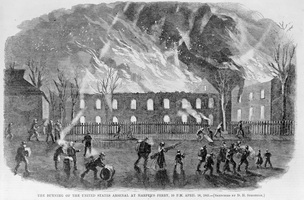 | Back to e-WV
| Back to e-WV
 The West Virginia Encyclopedia
The West Virginia Encyclopedia
 | Back to e-WV
| Back to e-WV
 The West Virginia Encyclopedia
The West Virginia Encyclopedia

In 1792, Congress authorized the building of two national arsenals for the storage of arms and, in 1794, provided funds for the building of two armories for the manufacture of small arms.
Harpers Ferry, occupying the strategic location where the Potomac and Shenandoah rivers meet in a gap in the Blue Ridge and blessed with abundant water power, was chosen as the southern of the two U.S. armories and arsenals. The other was built in Springfield, Massachusetts.
An industrial site was built from scratch in 1798. The first weapons were produced in 1799 and from then until the destruction of the armory in 1861, hundreds of thousands of muskets, rifles, and pistols were manufactured or assembled there. Spare parts were made at Harpers Ferry, as was ammunition. The U.S. Army and Navy carried these weapons into all of their military actions from the early 19th century to the Civil War. The Lewis and Clark Expedition was outfitted in large part at Harpers Ferry.
The building of a government industrial site should have helped the local economy, but the early evidence shows that this may not have been the case. Instead of using the local iron ore, Pennsylvania ore was shipped to the armory. Corruption and favoritism in the letting of contracts and hiring of skilled labor plagued the armory until the coming of the Chesapeake & Ohio Canal in 1833 and the Baltimore & Ohio Railroad in 1837. These new transportation routes made the Harpers Ferry area a hub of industrial and agricultural activity and opened up new jobs and markets.
Along with the textile mills of New England, Harpers Ferry was an important site in the Industrial Revolution in America. Important advances toward modern industrial methods were made there, including the organizing of factory-style production. The use of interchangeable parts, a prerequisite for modern manufacturing, was perfected at Hall’s Rifle Works at Harpers Ferry.
During the 1830s and 1840s, there were many changes in the production of the basic musket design at the armory. The development of more powerful gunpowder and the change from flintlock to percussion cap were the most important. By 1855, rifled muskets were being built at the armory by the thousands and marked with ‘‘HARPERS FERRY’’ on their lockplates.
With the raid by John Brown on the armory in October of 1859, the name Harpers Ferry became notorious across the United States. It became a prime military target two years later at the start of the Civil War. U.S. troops torched armory and arsenal buildings when they retreated from Harpers Ferry in April 1861, but incoming Virginia militia were able to extinguish the flames. Rebels occupied the site for the next two months, relocating machinery to the Confederate armory in Fayetteville, North Carolina. They set fire to the remaining buildings upon their own retreat in June. The armory was never rebuilt.
Written by Greg Carroll
Gilbert, Dave. Where Industry Failed: Water-Powered Mills at Harpers Ferry, West Virginia. Charleston: Pictorial Histories Publishing Company, 1984.
Brown, Stuart E. Jr. The Guns of Harpers Ferry. Berryville, VA: Virginia Book, 1968.
Gluckman, Arcadi. Identifying Old U.S. Muskets, Rifles, and Carbines. Harrisburg, PA: Stackpole Books, 1959.
Theriault, William D. A History of Eastern Jefferson County. Bakerton: Jefferson County Oral & Visual History Association, 1988.